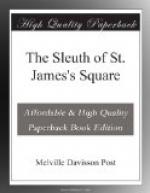“Sir Henry got half up on his feet with his energy in the solution of the thing. He thrust his spread-out fingers down. on the table like a man, by that gesture, pressing in an inevitable, conclusive summing up.”
The girl paused. “It was splendid, I thought. I applauded like an entranced pit!
“But Mr. Meadows didn’t say a word. He took up the big glass we had used about the inspection of the place, and passed it over the prints Sir Henry was unconsciously making in the dust on the polished surface of the table. Then he put the glass down and looked the excited baronet calmly in the face.
“`There,’ cried Sir Henry, `the thing’s no mystery.’
“For the first time Mr. Meadows opened his mouth. `It’s the profoundest mystery I ever heard of,’ he said.
“Sir Henry was astonished. He sat down and looked across the table at the man. He wasn’t able to speak for a moment, then he got it out: `Why exactly do you say that?’
“Mr. Meadows put his elbows on the table. He twiddled the big reading glass in his fingers. His face got firm and decided.
“`To begin with,’ he said, `the door to this house was never broken by a professional cracksman. It’s the work of a bungling amateur. A professional never undertakes to break a door at the lock. Naturally that’s the firmest place about a door. The implement he intends to use as a lever on the door he puts in at the top or bottom. By that means he has half of the door as a lever against the resistance of the lock. Besides, a professional of any criminal group is a skilled workman. He doesn’t waste effort. He doesn’t fracture a door around the lock. This door’s all mangled, splintered and broken around the lock.’”
“He stopped and looked about the room, and out through the window at the Scotland Yard patrol. The features of his face were contracted with the problem. One could imagine one saw the man’s mind laboring at the mystery. `And that’s not all,’ he said. `Your man Millson is not telling the truth. He didn’t see a dead body lying on the steps of this house; and he didn’t see a man running away.’
“Sir Henry broke in at that. `Impossible,’ he said; ’Millson’s a first-class inspector, absolutely reliable. Why do you say that he didn’t see the dead man on the steps or the assassin running away?’
“Mr. Meadows answered in the same even voice. `Because there was never any dead man here,’ he said, `for anybody to see. And because Millson’s ’description of the man he saw is scientifically an impossible feat of vision.’
“Impossible?’ cried Sir Henry.
“`Quite impossible,’ Mr. Meadows insisted. ’Millson tells us that the man he saw running away in the night wore a blue coat and reddish-brown trousers. He says he was barely able to distinguish the blue coat, but that he could see the reddish-brown trousers very clearly. Now, as a matter of fact, it has been very accurately determined that red is the hardest color to distinguish at night, and blue the very easiest. A blue coat would be clearly visible long after reddish-brown trousers had become indistinguishable in the darkness.’




